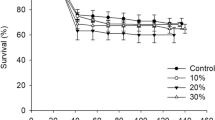Abstract
A method for steady production of Chilo partellus has been established. An efficient simple and easy method of collection of first instar larvae from incubation chambers has been developed. It has been established that pupae of Chilo partellus can be held at a chilling temperature between 5 and 15°C without any adverse effect on the emergence of adults. This finding has been used in synchronizing the emergence of males and females for mating or longer storage of the pupae.
Studies on the effect of high and low humidities on egg development have shown that low humidities affect the hatchability of Chilo partellus egg but did not effect the actual development of the embryo adversely. It has also been shown that Chilo partellus oviposits best under high humidity.
Résumé
Une methode de stabilisation de production du Chilo partellus a été établie. Une méthode efficace, simple et facile pour recueillir les premiers instars des larves, des chambres d’incubation a été développée. Il a été établie que la pupe du Chilo partellus peut être tenue a des températures très froides entre 5 et 15°C sans aucun effet défavorable sur l’émergence des insectes. Cette décourverte a été utilisée dans la synchronisation de l’emergence des mâles et femelles pour accouplement ou pour une conservation plus longue de la pupe. Des études sur l’effet d’une humidité basse ou élevée sur le développement de l’oeuf ont montré que une basse humidité affecte l’éclosion de l’oeuf du Chilo partellus mais n’affecte pas défavorablement le développement de l’embryon. Il a été aussi montré que Chilo partellus ovipose mieux dans des conditions d’humidité élevée.
Similar content being viewed by others
References
Madge D. S. (1961) The control of relative humidities with aqueous solutions of sodium hydroxide. Entomologia exp. appl. 4, 143–147.
Seshu Reddy K. V. and Davies J. C. (1979) A new medium for mass-rearing of sorghum stem-borer, Chilo partellus Swinhoe (Lepidoptera: Pyralidae) and its use in resistance screening. Ind. J. PI. Protect. VI, 48–55.
Sharma V. K. and Sarup P. (1978) Formulation of suitable artificial diets for rearing the maize stalk-borer, Chilo partellus (Swinhoe) in the laboratory. J. ent. Res. 2, 43–48.
Siddiqui K. H. and Chatterji S. M. (1972) Laboratory rearing of the maize stem-borer, Chilo zonellus Swinhoe (Crambidae: Lepidoptera) on a semi-synthetic diet using indigenous ingredients. Indian J. Ent. 34, 183–185.
Siddiqui K. H., Sarup P., Panwar V. P. S. and Marwaha K. K. (1977) Evolution of base-ingredients to formulate artificial diets for the mass-rearing of Chilo partellus (Swinhoe). J. ent. Res. I, 117–131.
Author information
Authors and Affiliations
Rights and permissions
About this article
Cite this article
Ochieng, R.S., Onyango, F.O. & Bungu, M.D.O. Improvement of Techniques for Mass-Culture of Chilo partellus (Swinhoe). Int J Trop Insect Sci 6, 425–428 (1985). https://doi.org/10.1017/S1742758400004744
Received:
Revised:
Published:
Issue Date:
DOI: https://doi.org/10.1017/S1742758400004744
Key Words
- Chilo partellus
- mass-culture
- base-ingredients
- resistance
- artificial diet
- Penicillium
- Fusarium
- Aspergillus
- benomyl




